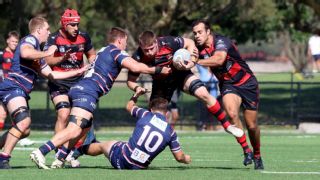As we count down to the 2024 Shute Shield season kickoff, every side has spent the summer preparing for another grueling year, with a new tackle law front of mind.
Announced by Rugby Australia at the end of 2023 and introduced over the summer preseason, all community level rugby from Shute Shield down will see the legal tackle height reduced from shoulder to sternum level, as part of a two-year trial in a bid to reduce concussions.
It comes into line with the likes of England, New Zealand and South Africa who have implemented their own reduced tackle height laws over the last few years.
While there's been plenty of detractors to the change, Norths coach Zak Beer has challenged his side to embrace the new law and look to the positives that it could introduce.
"My mindset was a little bit different with it," Beer told ESPN. "I think you can get frustrated and try and wish that things were the old way, but we really just tried to embrace it.
"We've always played quite an attacking brand of rugby, so it suits us because it certainly frees up the ball and allows that fluid movement of the ball post-contact, which is something we've always tried to promote amongst our players.
"On the defensive side, we're typically more of a chop tackle and on ball focus, I think we've dominated the breakdown steal numbers over the last few years, so from a systems perspective it's probably the easiest adjustment for us."

For some taller and larger players the reduction in height adds another level of difficulty to the game, but Beer was surprised by how quickly his squad accepted the change and came in with a fresh mindset.
"The players jumped on board a lot quicker than I anticipated, to be honest.
"I think clarity is a big thing and I think when the laws were first released, there was a lot of grey area. There still is referee's discretion around the tackled player and mitigation around the attacker dipping into contact, but also we revert back to the old laws if it's a pick and drive scenario or even if it's a pick and pop scenario.
"The only frustration that came out of our players was the changing gears between the new laws and the old laws depending on the scenario and then having to adjust playing a full contact game, whilst also trying to stop the attacker and not give away a penalty. That's probably been the main cause of frustration.
"Some of our guys have naturally always struggled to get quite low, but we think that within a few months, everyone will be adjusted as close as possible to the new laws, and they'll be well within their flows and habits by then."
Just up the Pacific Highway, Norths' long-time rivals Gordon have also spent much of their preseason focused on reducing the impact of the law, including strapping rugby balls to tackle bags to replicate the action of tackling below the ball carry, while they've even gone as far as to hire their own in-house referee in former Waratahs and Brumbies player and first grade referee Dylan Sigg.
"We've done an awful lot of work with him reffing our training sessions on a regular basis to get used to having to adjust," Gordon coach Harry Fehily told ESPN. "But we're also using him to liaise with a couple of the referees and NSW panel to get their interpretation of what they're looking for and just to understand what picture they are ultimately looking at in each individual tackle.
"Generally the ball carrier will carry the ball at nipple level so as long as we're hitting under the ball, that's generally a good principal to be working off and if you're hitting on the ball as a defender, that's generally a penalty."

While Fehily was happy to see rugby continue to work at reducing the risk of concussions and long-term head injuries, he was also left frustrated by the quick introduction of another law, questioning whether there had been enough time to see results following earlier tackle height changes.
"My general gut feeling is we just need to stop tampering with the game. I understand there's issues that we need to deal with in terms of mitigating head knocks, but ultimately, I don't know whether even some of the law changes they made in the last couple of years, if they've left enough time to actually see what the outcomes of those changes have been.
"They'll say that they've done a few bits and pieces in different countries in terms of trialing the tackle height law over the last year or two, but they changed the tackle height law a couple of years ago here as well and you kind of think 'how do we know if those laws had any meaningful impact on concussions and would in the future?' I don't know. Have they left enough time for those things to actually come to fruition? Probably not.
"I get frustrated like everybody else at the number of law changes that happen on a regular basis. It's just becoming harder and more complicated to follow basically."
For many fans and players one of the biggest issues around the law change was the increased number of penalties it was likely to generate and how it would impact the game as a whole. And while Fehily admits there's some pessimism in the lower grades, he still believes the issue has been blown out of proportion.
"First of all, I probably don't think it's going to be as bad as all the noise around it," Fehily told ESPN.

"I think there's an awful lot of noise in terms of it's going to disrupt the game massively, it's going to create large penalty counts each week, and I can imagine in the first couple of rounds there's going to be a bit of teething issues, but in general, I just think that there's maybe just too much hype about it, I just don't think it's going to be as bad as people think.
"I don't know whether it was the work we've done in preseason so far, but in our first trial game against the Rats we only gave away eight penalties in the entire game, and I think only two of them were from tackle height, so in general that's pretty low to be totally honest, and I think it was pretty similar in our second trial, I think it was only 13 penalties in total and I think three or four were for tackle height.
"I think where it's probably going to get pretty messy is I'd imagine in some of the lower grade games. In those games you often get some younger refs who are quite inexperienced and they're trying to prove a point to some of the referee selectors and you'd be a bit worried that you're going to see an awful lot of penalties and it will just kill the whole flow of the game. There's going to be a lot of frustration, so there's a bit of angst in the lower grades as to what it's going to be like."
The biggest unanticipated issue both Beer and Fehily have come across so far though, has actually been the risk of head-on-head collisions between two defenders as they both attempt to stop the ball carrier. With players forced to go lower and sometimes coming from a blind angle, both coaches have witnessed an increase in head knocks.
"I think the only thing we've got to look for, which we've seen in a couple of games already, is if defensive player one and defensive player two both go low at the same time either side of the attacker, they come around the body and clash heads," Beer said.
"That's happened a couple of times, and that's happened in lower grades as well, but that might just be something we have to watch for."
Fehily noted Gordon had experienced the same issue resulting in more in-training concussion than they had seen previously.
"What's happening is that in dual contact, when you get two guys going in at the same height, what we found a couple of times, you get head clashes between the two defenders because you get one guy going in from one side, the other guy going in from the other side, they swing around and clash heads.
"So we've actually seen an increase so far in training concussions, compared to what we had in the last couple of years. What we've generally found is that we've seen more head knocks from defenders actually knocking heads with each other."
There is a positive according to Beer though, he believes the changes will be a benefit to the sport with a return to a more dynamic and free-flowing game with the ability to offload in tackles opening the game back up for smaller agile players and moving away from power-based play.
"It definitely will [open up a freer flowing game]," Beer said. "The average ruck speed over the last few years in the Shute Shield is about 3.4 seconds, I expect that to go below three seconds this year with the new laws.
"What it does is it opens up the game for some of our smaller players again, like the jackal or the specialist on ball back-rower becomes even more prevalent, whereas before there was probably a trend for teams picking bigger, more physical sides, so that's a positive and it also sees the skillful players come back into vogue.
"If you have an ability to keep the ball alive and have the skillset to pass through contact and offload well then you'll be promoting the ball and probably getting picked in in the higher grades.
"We want to see rugby be the game for all profiles and what we're doing is bringing back the more dynamic, probably quicker smaller players, whereas we have been seeing a trend towards more of a power game, definitely over the last decade."
